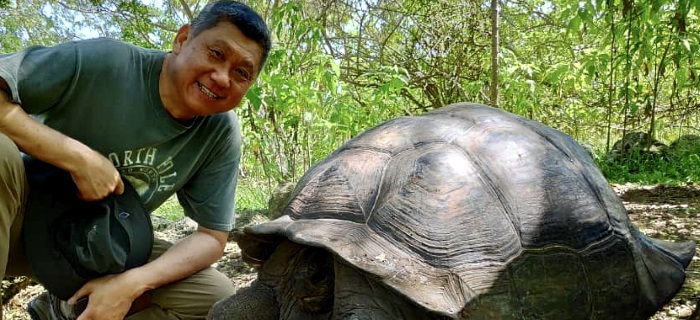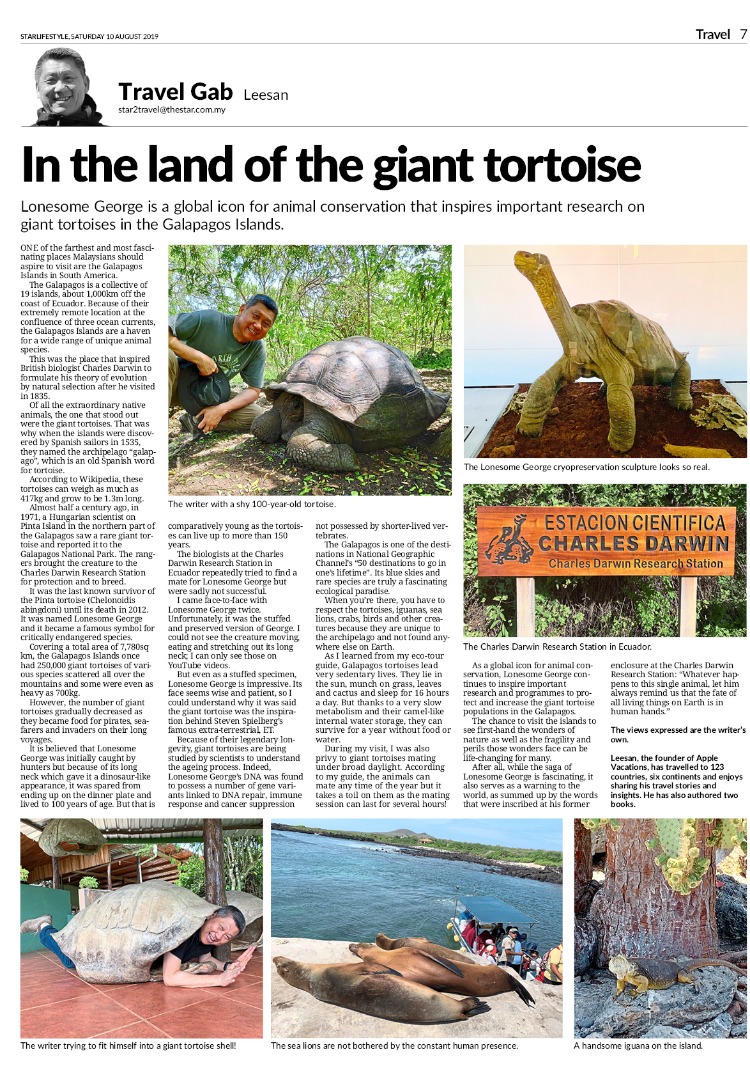The Galapagos is a collective of 19 islands, about 1,000km off the coast of Ecuador. Because of their extremely remote location at the confluence of three ocean currents, the Galapagos Islands are a haven for a wide range of unique animal species.
In Galapagos, the land of the giant tortoise — by Leesan

One of the farthest and most fascinating places Malaysians should aspire to visit are the Galapagos Islands in South America.
The Galapagos is a collective of 19 islands, about 1,000km off the coast of Ecuador. Because of their extremely remote location at the confluence of three ocean currents, the Galapagos Islands are a haven for a wide range of unique animal species.
This was the place that inspired British biologist Charles Darwin to formulate his theory of evolution by natural selection after he visited in 1835.
Of all the extraordinary native animals, the one that stood out were the giant tortoises. That was why when the islands were discovered by Spanish sailors in 1535, they named the archipelago “galapago”, which is an old Spanish word for tortoise.
According to Wikipedia, these tortoises can weigh as much as 417kg and grow to be 1.3m long.
Almost half a century ago, in 1971, a Hungarian scientist on Pinta Island in the northern part of the Galapagos saw a rare giant tortoise and reported it to the Galapagos National Park. The rangers brought the creature to the Charles Darwin Research Station for protection and to breed.
It was the last known survivor of the Pinta tortoise (Chelonoidis abingdoni) until its death in 2012. It was named Lonesome George and it became a famous symbol for critically endangered species.
Covering a total area of 7,780sq km, the Galapagos Islands once had 250,000 giant tortoises of various species scattered all over the mountains and some were even as heavy as 700kg.
However, the number of giant tortoises gradually decreased as they became food for pirates, seafarers and invaders on their long voyages.
It is believed that Lonesome George was initially caught by hunters but because of its long neck which gave it a dinosaur-like appearance, it was spared from ending up on the dinner plate and lived to 100 years of age. But that is comparatively young as the tortoises can live up to more than 150 years.
The biologists at the Charles Darwin Research Station in Ecuador repeatedly tried to find a mate for Lonesome George but were sadly not successful.

I came face-to-face with Lonesome George twice. Unfortunately, it was the stuffed and preserved version of George. I could not see the creature moving, eating and stretching out its long neck; I can only see those on YouTube videos.
But even as a stuffed specimen, Lonesome George is impressive. Its face seems wise and patient, so I could understand why it was said the giant tortoise was the inspiration behind Steven Spielberg’s famous extra-terrestrial, ET.
Because of their legendary longevity, giant tortoises are being studied by scientists to understand the ageing process. Indeed, Lonesome George’s DNA was found to possess a number of gene variants linked to DNA repair, immune response and cancer suppression not possessed by shorter-lived vertebrates.
The Galapagos is one of the destinations in National Geographic Channel’s “50 destinations to go in one’s lifetime”. Its blue skies and rare species are truly a fascinating ecological paradise.
When you’re there, you have to respect the tortoises, iguanas, sea lions, crabs, birds and other creatures because they are unique to the archipelago and not found anywhere else on Earth.
As I learned from my eco-tour guide, Galapagos tortoises lead very sedentary lives. They lie in the sun, munch on grass, leaves and cactus and sleep for 16 hours a day. But thanks to a very slow metabolism and their camel-like internal water storage, they can survive for a year without food or water.
During my visit, I was also privy to giant tortoises mating under broad daylight. According to my guide, the animals can mate any time of the year but it takes a toil on them as the mating session can last for several hours!
As a global icon for animal conservation, Lonesome George continues to inspire important research and programmes to protect and increase the giant tortoise populations in the Galapagos.
The chance to visit the islands to see first-hand the wonders of nature as well as the fragility and perils those wonders face can be life-changing for many.
After all, while the saga of Lonesome George is fascinating, it also serves as a warning to the world, as summed up by the words that were inscribed at his former enclosure at the Charles Darwin Research Station: “Whatever happens to this single animal, let him always remind us that the fate of all living things on Earth is in human hands.”

全球超过80000家酒店,Apple101助您轻松订房,出行无忧,绝对优惠价。入住期间付款,多数客房可免费取消!




















